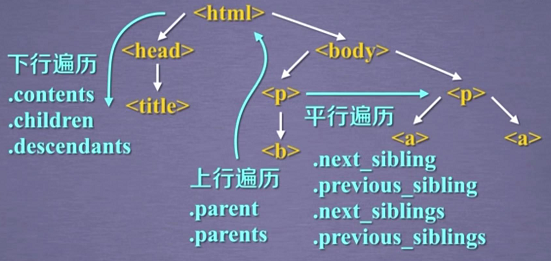Beautiful Soup:美味汤
非常优秀的python第三方库
能够对html、xml格式进行解析,并且提取其中的相关信息
Beautiful Soup可以对你提供给他的任何格式进行相关的爬取,并且可以进行树形解析
使用原理:把任何你给他的文档当成一锅汤,然后煲制这锅汤
一、安装:
pip3 install beautifulsoup4
HTML页面是以尖括号为主的一些标签封装的一些信息
>>> import requests
>>> r=requests.get("https://python123.io/ws/demo.html")
>>> r.text
'<html><head><title>This is a python demo page</title></head>
<body>
<p class="title"><b>The demo python introduces several python courses.</b></p>
<p class="course">Python is a wonderful general-purpose programming language. You can learn Python from novice to professional by tracking the following courses:
<a href="http://www.icourse163.org/course/BIT-268001" class="py1" id="link1">Basic Python</a> and <a href="http://www.icourse163.org/course/BIT-1001870001" class="py2" id="link2">Advanced Python</a>.</p>
</body></html>'
>>> demo=r.text
>>> from bs4 import BeautifulSoup#bs4是beautifulsoup4库的简写,从bs4 库导入BeautifulSoup类
#soup 变量就代表了我们解析后的demo页面
>>> soup = BeautifulSoup(demo,"html.parser") #第一个参数是我们需要BeautifulSoup解析的一个html信息,可以用'<p>data</p>'来做个代替,也可以使用任何变量,第二个参数是解析这锅汤所用的解析器(html.parser解析demo的解析器,对demo进行html的解析)
>>> print(soup.prettify())
BeautifulSoup库成功的解析了我们给出的demo页面

二、Beautiful Soup库的基本元素
BeautifulSoup库的引用
BeautifulSoup库,也叫beautifulsoup4库或bs4库
from bs4 import BeautifulSoup (从bs4引用一个类型BeautifulSoup)
import bs4 (对BeautifulSoup库里的一些变量进行判断)
BeautifulSoup库本身解析html、xml文档,这个文档与标签树一一对应,经过了BeautifulSoup类的处理,可以把标签树(可以理解为字符串)转换成BeautifulSoup类,BeautifulSoup类就是一个能代表标签树的类型,实际上,可以认为HTML文档<---------->标签树<---------->BeautifulSoup类三者是等价的
通过BeautifulSoup类使得标签树形成了一个变量,而对这个变量的处理,就是对标签树的相关处理
简单讲,我们可以把BeautifulSoup类当做对应一个HTML/XML文档的全部内容
Beautiful Soup库的解析器
解析器 使用方法 条件
bs4的HTML解析器 BeautifulSoup(mk,'html.parser') 安装bs4库
lxml的HTML解析器 BeautifulSoup(mk,'lxml') pip install lxml
lxml的xml解析器 BeautifulSoup(mk,'html.xml') pip install lxml
html5lib的解析器 BeautifulSoup(mk,'html5lib') pip install html5lib
Beautiful Soup类的基本元素
基本元素 说明
Tag 标签,最基本的信息组织单元,分别用<>和</>标明开头和结尾
Name 标签的名字,<p>...</p>的名字是‘p’,格式:<tag>.name
Attributes 标签的属性,字典形式组织,格式:<tag>.attrs,无属性会返回空字典
NavigableString 标签内非属性字符串,<>...</>中字符串,格式:<tag>.string
Comment 标签内字符串的注释部分,一种特殊的Comment类型
看页面title
>>> soup.title
<title>This is a python demo page</title>
>>> tag=soup.a #有多个,只能获得第一个a标签的信息
>>> tag
<a class="py1" href="http://www.icourse163.org/course/BIT-268001" id="link1">Basic Python</a>
>>> soup.a.name #获得a标签的名字,字符串类型
'a'
>>> soup.a.parent.name #获得a标签的父标签的名字
'p'
>>> soup.a.parent.parent.name
'body'
>>> tag=soup.a
>>> tag.attrs #获得标签属性,字典类型
{'href': 'http://www.icourse163.org/course/BIT-268001', 'class': ['py1'], 'id': 'link1'}
>>> tag.attrs['class']
['py1']
>>> tag.attrs['href']
'http://www.icourse163.org/course/BIT-268001'
>>> type(tag.attrs)
<class 'dict'>
>>> type(tag)
<class 'bs4.element.Tag'>
>>> soup.a
<a class="py1" href="http://www.icourse163.org/course/BIT-268001" id="link1">Basic Python</a>
>>> soup.a.string
'Basic Python'
>>> soup.p
<p class="title"><b>The demo python introduces several python courses.</b></p>
>>> soup.p.string
'The demo python introduces several python courses.' #没有打印b标签,说明NavigableString是可以跨越多个标签层次的
>>> type(soup.p.string)
<class 'bs4.element.NavigableString'>#bs4库定义的类型
>>> newsoup = BeautifulSoup("<b><!--This is a comment--></b><p>This is not a comment</p>","html.parser") #<--表示一个注释的开始
>>> newsoup.b.string #不需要提取注释信息,需要对相关类型进行判断
'This is a comment'
>>> type(newsoup.b.string)
<class 'bs4.element.Comment'>
>>> newsoup.p.string
'This is not a comment'
>>> type(newsoup.p.string)
<class 'bs4.element.NavigableString'>
三、基于bs4库的HTML内容遍历方法
HTML基本格式

下行遍历:
属性 说明
.contents 子节点的列表,将<tag>所有儿子节点存入列表
.children 子节点的迭代类型,与.contents类似,用于循环遍历儿子节点
.descendants 子孙节点的迭代类型,包含所有子孙节点,用于循环遍历
>>> soup.head
<head><title>This is a python demo page</title></head>
>>> soup.head.contents
[<title>This is a python demo page</title>]
>>> soup.body.contents #对于一个标签的儿子节点,不仅仅包括标签节点,也包括字符串节点,比如像'
'的回车,他也是一个body标签的儿子节点类型
['
', <p class="title"><b>The demo python introduces several python courses.</b></p>, '
', <p class="course">Python is a wonderful general-purpose programming language. You can learn Python from novice to professional by tracking the following courses:
<a class="py1" href="http://www.icourse163.org/course/BIT-268001" id="link1">Basic Python</a> and <a class="py2" href="http://www.icourse163.org/course/BIT-1001870001" id="link2">Advanced Python</a>.</p>, '
']
>>> len(soup.body.contents)
5
>>> soup.body.contents[1]
<p class="title"><b>The demo python introduces several python courses.</b></p>
for child in soup.body.children:
print(child)
for child in soup.body.children:
print(child)
上行遍历:
属性 说明
.parent 节点的父亲标签
.parents 节点先辈标签的迭代类型,用于循环遍历先辈节点
>>> soup = BeautifulSoup(demo,'html.parser')
>>> for parent in soup.a.parents:
... if parent is None:
... print(parent)
... else:
... print(parent.name)
...
p
body
html
[document]
#在遍历一个标签的所有先辈标签时,会遍历到soup本身,而soup的先辈并不存在.name的信息,在这种情况下需要做一个区分,如果先辈是None就不能打印这部分信息了
平行遍历:
属性 说明
.next_sibling 返回按照HTML文本顺序的下一个平行节点标签
.previous_sibling 返回按照HTML文本顺序的上一个平行节点标签
.next_siblings 迭代类型,返回按照HTML文本顺序的后续所有平行节点标签
.previous_siblings 迭代类型,返回按照HTML文本顺序的前续所有平行节点标签

>>> soup.a.next_sibling #a标签的下一个平行节点是一个字符串and,这里注意一下,在标签树中,尽管树形结构采用的是标签的形式来组织,但是标签之间的NavigableString 也构成了标签的节点,也就是说,任何一个节点,他的平行标签,他的儿子标签是可能存在NavigableString 类型的,所以并不能想当然的认为,平行遍历获得的节点一定是标签类型。
' and '
>>> soup.a.next_sibling.next_sibling
<a class="py2" href="http://www.icourse163.org/course/BIT-1001870001" id="link2">Advanced Python</a>
>>> soup.a.previous_sibling
'Python is a wonderful general-purpose programming language. You can learn Python from novice to professional by tracking the following courses:
'
>>> soup.a.previous_sibling.previous_sibling #空信息
>>> soup.a.parent
<p class="course">Python is a wonderful general-purpose programming language. You can learn Python from novice to professional by tracking the following courses:
<a class="py1" href="http://www.icourse163.org/course/BIT-268001" id="link1">Basic Python</a> and <a class="py2" href="http://www.icourse163.org/course/BIT-1001870001" id="link2">Advanced Python</a>.</p>
#遍历后续节点
>>> for sibling in soup.a.next_siblings:
... print(sibling)
...
and
<a class="py2" href="http://www.icourse163.org/course/BIT-1001870001" id="link2">Advanced Python</a>
.#遍历前续节点
>>> for sibling in soup.a.previous_siblings:
... print(sibling)
...
Python is a wonderful general-purpose programming language. You can learn Python from novice to professional by tracking the following courses:
>>>

四、基于bs4库的HTML格式化和编码
>>> soup.prettify() #每一个标签后面加了一个换行符
'<html>
<head>
<title>
This is a python demo page
</title>
</head>
<body>
<p class="title">
<b>
The demo python introduces several python courses.
</b>
</p>
<p class="course">
Python is a wonderful general-purpose programming language. You can learn Python from novice to professional by tracking the following courses:
<a class="py1" href="http://www.icourse163.org/course/BIT-268001" id="link1">
Basic Python
</a>
and
<a class="py2" href="http://www.icourse163.org/course/BIT-1001870001" id="link2">
Advanced Python
</a>
.
</p>
</body>
</html>'
>>> print(soup.prettify()) #每一个标签以及相关内容都分行显示
<html>
<head>
<title>
This is a python demo page
</title>
</head>
<body>
<p class="title">
<b>
The demo python introduces several python courses.
</b>
</p>
<p class="course">
Python is a wonderful general-purpose programming language. You can learn Python from novice to professional by tracking the following courses:
<a class="py1" href="http://www.icourse163.org/course/BIT-268001" id="link1">
Basic Python
</a>
and
<a class="py2" href="http://www.icourse163.org/course/BIT-1001870001" id="link2">
Advanced Python
</a>
.
</p>
</body>
</html>
>>>
prettify这个方法能够为html文本的标签和内容增加换行符,他也可以对每一个标签进行相关处理
>>> print(soup.a.prettify())
<a class="py1" href="http://www.icourse163.org/course/BIT-268001" id="link1">
Basic Python
</a>
bs4库将任何读入的html文件或字符串都转换成了utf8编码,utf8编码是国际通用的标准编码格式,他能够很好的支持中文等第三国的语言,由于py3.x默认支持编码是utf8,因此在做相关解析的时候,使用bs4库并没有相关障碍
>>> soup = BeautifulSoup("<p>中文</p>","html.parser")
>>> soup.p.string
'中文'
>>> print(soup.p.prettify())
<p>
中文
</p>
>>>
总结:BeautifulSoup是用来解析html、xml文档的功能库,可以使用from bs4 import BeautifulSoup引入BeautifulSoup类型,并用这个类型加载相关的解析器,来解析一个变量出来,这个变量就是用来提取信息和遍历信息的BeautifulSoup的类型